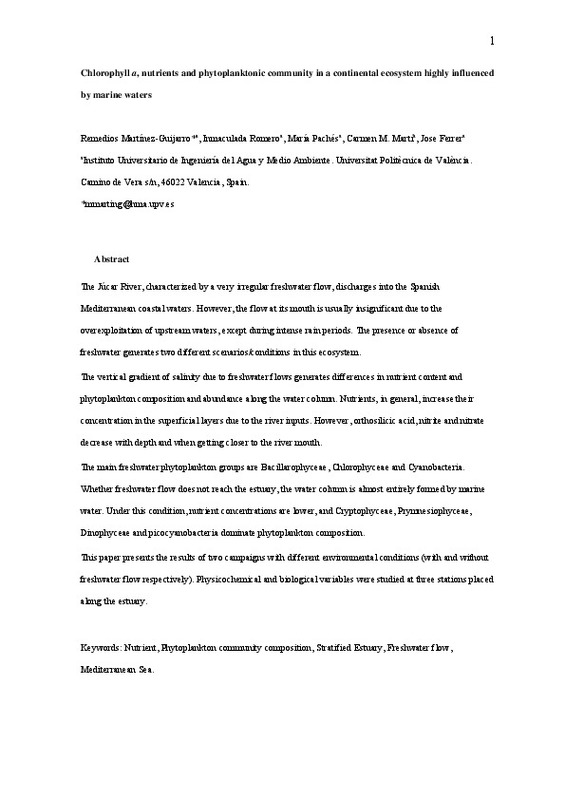JavaScript is disabled for your browser. Some features of this site may not work without it.
Buscar en RiuNet
Listar
Mi cuenta
Estadísticas
Ayuda RiuNet
Admin. UPV
Chlorophyll a, nutrients and phytoplanktonic community in a continental ecosystem highly influenced by marine waters
Mostrar el registro sencillo del ítem
Ficheros en el ítem
| dc.contributor.author | Martínez Guijarro, Mª Remedios
|
es_ES |
| dc.contributor.author | Romero Gil, Inmaculada
|
es_ES |
| dc.contributor.author | Pachés Giner, María Aguas Vivas
|
es_ES |
| dc.contributor.author | Martí Insa, Carmen Mª
|
es_ES |
| dc.contributor.author | Ferrer Polo, José
|
es_ES |
| dc.date.accessioned | 2014-10-14T15:11:57Z | |
| dc.date.available | 2014-10-14T15:11:57Z | |
| dc.date.issued | 2013-04 | |
| dc.identifier.issn | 0022-0981 | |
| dc.identifier.uri | http://hdl.handle.net/10251/43262 | |
| dc.description.abstract | The Júcar River, characterized by a very irregular freshwater flow, discharges into the Spanish Mediterranean coastal waters. However, the flow at its mouth is usually insignificant due to the overexploitation of upstream waters, except during intense rain periods. The presence or absence of freshwater generates two different scenarios/conditions in this ecosystem. The vertical gradient of salinity due to freshwater flows generates differences in nutrient content and phytoplankton composition and abundance along the water column. Nutrients, in general, increase their concentration in the superficial layers due to the river inputs. However, orthosilicic acid, nitrite and nitrate decrease with depth and when getting closer to the river mouth. The main freshwater phytoplankton groups are Bacillariophyceae, Chlorophyceae and Cyanobacteria. Whether or not freshwater flow reaches the estuary, the water column is almost entirely formed by marine water. Under this condition, nutrient concentrations are lower, and Cryptophyceae, Prymnesiophyceae, Dinophyceae and picocyanobacteria dominate phytoplankton composition. This paper presents the results of two campaigns with different environmental conditions (with and without freshwater flow respectively). Physicochemical and biological variables were studied at three stations placed along the estuary. | es_ES |
| dc.description.sponsorship | This research work has been supported by the Generalitat Valenciana as part of the works belonging to the Water Framework Directive. [SS] | en_EN |
| dc.language | Inglés | es_ES |
| dc.publisher | Elsevier | es_ES |
| dc.relation.ispartof | Journal of Experimental Marine Biology and Ecology | es_ES |
| dc.rights | Reserva de todos los derechos | es_ES |
| dc.subject | Freshwater flow | es_ES |
| dc.subject | Mediterranean Sea | es_ES |
| dc.subject | Nutrient | es_ES |
| dc.subject | Phytoplankton community composition | es_ES |
| dc.subject | Stratified estuary | es_ES |
| dc.subject.classification | TECNOLOGIA DEL MEDIO AMBIENTE | es_ES |
| dc.title | Chlorophyll a, nutrients and phytoplanktonic community in a continental ecosystem highly influenced by marine waters | es_ES |
| dc.type | Artículo | es_ES |
| dc.identifier.doi | 10.1016/j.jembe.2013.01.026 | |
| dc.rights.accessRights | Abierto | es_ES |
| dc.contributor.affiliation | Universitat Politècnica de València. Departamento de Ingeniería Hidráulica y Medio Ambiente - Departament d'Enginyeria Hidràulica i Medi Ambient | es_ES |
| dc.contributor.affiliation | Universitat Politècnica de València. Instituto Universitario de Ingeniería del Agua y del Medio Ambiente - Institut Universitari d'Enginyeria de l'Aigua i Medi Ambient | es_ES |
| dc.description.bibliographicCitation | Martínez Guijarro, MR.; Romero Gil, I.; Paches Giner, MAV.; Martí Insa, CM.; Ferrer Polo, J. (2013). Chlorophyll a, nutrients and phytoplanktonic community in a continental ecosystem highly influenced by marine waters. Journal of Experimental Marine Biology and Ecology. 442:30-38. doi:10.1016/j.jembe.2013.01.026 | es_ES |
| dc.description.accrualMethod | S | es_ES |
| dc.relation.publisherversion | http://dx.doi.org/10.1016/j.jembe.2013.01.026 | es_ES |
| dc.description.upvformatpinicio | 30 | es_ES |
| dc.description.upvformatpfin | 38 | es_ES |
| dc.type.version | info:eu-repo/semantics/publishedVersion | es_ES |
| dc.description.volume | 442 | es_ES |
| dc.relation.senia | 255498 | |
| dc.contributor.funder | Generalitat Valenciana | es_ES |







![[Cerrado]](/themes/UPV/images/candado.png)

